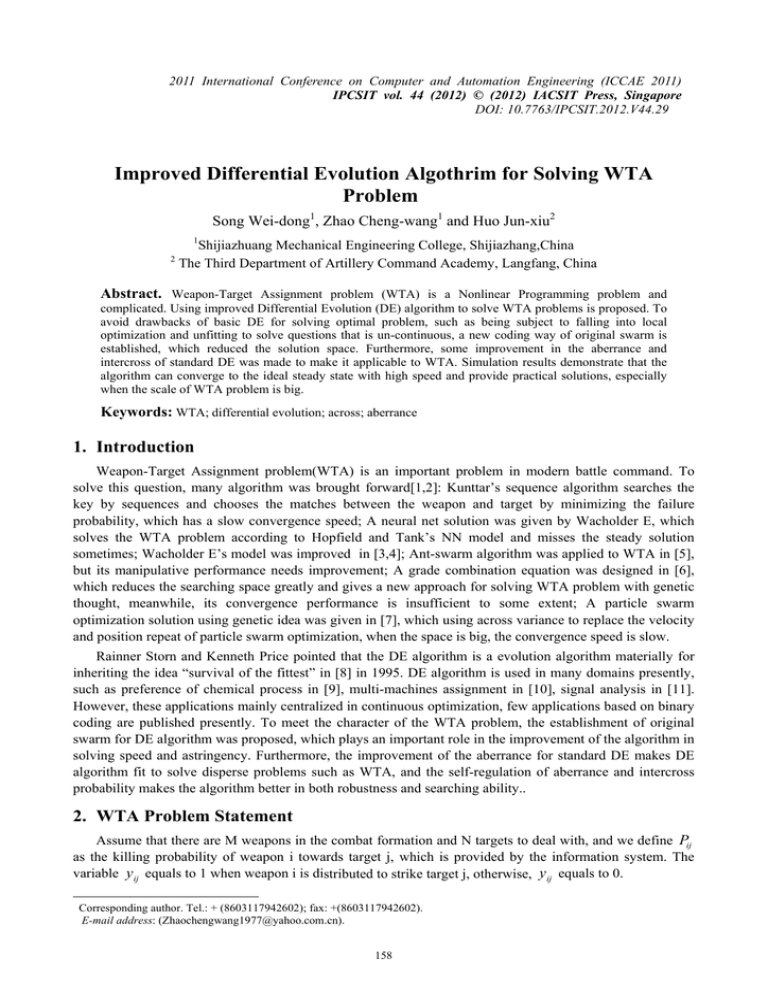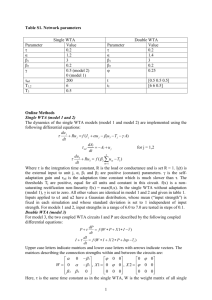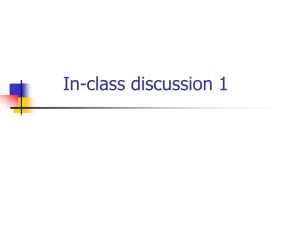Document 13136449
advertisement

2011 International Conference on Computer and Automation Engineering (ICCAE 2011) IPCSIT vol. 44 (2012) © (2012) IACSIT Press, Singapore DOI: 10.7763/IPCSIT.2012.V44.29 Improved Differential Evolution Algothrim for Solving WTA Problem1 Song Wei-dong1, Zhao Cheng-wang1 and Huo Jun-xiu2 1 2 Shijiazhuang Mechanical Engineering College, Shijiazhang,China The Third Department of Artillery Command Academy, Langfang, China Abstract. Weapon-Target Assignment problem (WTA) is a Nonlinear Programming problem and complicated. Using improved Differential Evolution (DE) algorithm to solve WTA problems is proposed. To avoid drawbacks of basic DE for solving optimal problem, such as being subject to falling into local optimization and unfitting to solve questions that is un-continuous, a new coding way of original swarm is established, which reduced the solution space. Furthermore, some improvement in the aberrance and intercross of standard DE was made to make it applicable to WTA. Simulation results demonstrate that the algorithm can converge to the ideal steady state with high speed and provide practical solutions, especially when the scale of WTA problem is big. Keywords: WTA; differential evolution; across; aberrance 1. Introduction Weapon-Target Assignment problem(WTA) is an important problem in modern battle command. To solve this question, many algorithm was brought forward[1,2]: Kunttar’s sequence algorithm searches the key by sequences and chooses the matches between the weapon and target by minimizing the failure probability, which has a slow convergence speed; A neural net solution was given by Wacholder E, which solves the WTA problem according to Hopfield and Tank’s NN model and misses the steady solution sometimes; Wacholder E’s model was improved in [3,4]; Ant-swarm algorithm was applied to WTA in [5], but its manipulative performance needs improvement; A grade combination equation was designed in [6], which reduces the searching space greatly and gives a new approach for solving WTA problem with genetic thought, meanwhile, its convergence performance is insufficient to some extent; A particle swarm optimization solution using genetic idea was given in [7], which using across variance to replace the velocity and position repeat of particle swarm optimization, when the space is big, the convergence speed is slow. Rainner Storn and Kenneth Price pointed that the DE algorithm is a evolution algorithm materially for inheriting the idea “survival of the fittest” in [8] in 1995. DE algorithm is used in many domains presently, such as preference of chemical process in [9], multi-machines assignment in [10], signal analysis in [11]. However, these applications mainly centralized in continuous optimization, few applications based on binary coding are published presently. To meet the character of the WTA problem, the establishment of original swarm for DE algorithm was proposed, which plays an important role in the improvement of the algorithm in solving speed and astringency. Furthermore, the improvement of the aberrance for standard DE makes DE algorithm fit to solve disperse problems such as WTA, and the self-regulation of aberrance and intercross probability makes the algorithm better in both robustness and searching ability.. 2. WTA Problem Statement Assume that there are M weapons in the combat formation and N targets to deal with, and we define Pij as the killing probability of weapon i towards target j, which is provided by the information system. The variable y ij equals to 1 when weapon i is distributed to strike target j, otherwise, y ij equals to 0. Corresponding author. Tel.: + (8603117942602); fax: +(8603117942602). E-mail address: (Zhaochengwang1977@yahoo.com.cn). 158 WTA problem takes the damage of the targets or the consumption of the ammunition as the objective function. The damage of the targets is selected to be the objective function in this paper, which can be defined as N M min E = ∑∏ (1 − Pij y ij ) (1) j =1 i =1 Subject to M ∑y j =1 ij ≤ t i , i = 1,2," , N N ∑t i =1 N i ∑y i =1 (2) ≤M (3) ≤1 (4) ij Where t i is the maximal number of weapons that can be assigned to a target at one time. 3. Solving the WTA problem with DE algorithm 3.1. The Mechanism of DE Algorithm to Solve the WTA Problem C The basic thought of differential evolutional algorithm is that every new individual will compete with a individual from father generation after the aberrance and across and the fitter individual survive, which makes the new individual superior to the father generation. In the DE algorithm, All individuals are given the equal chance to produce the new generation, which plays an important role to keep the diversity of the swarm. Obviously, DE algorithm is a applicable tool to solve problems in real number space. To solve WTA problem whose solution belongs to three-dimension space, there is many obstacles to realize the operation of basic vector and coefficient vector in aberrance process according to the standard DE algorithm. In this paper, the aberrance process is realized by the self-regulation of aberrance probability, which reduces the aberrance degree to avoid missing the most excellent solution when the objective position is near. 3.2. Improvement of the Aberrance The standard DE algorithm is designed to solve questions in real number space, so the across and aberrance operation is inapplicable to solve questions described with binary coding, corresponding adjust must be adopted. To WTA problem, the difference between two valid solutions can’t be described exactly, of course there is difficulty to give proper authority to the valid solution. Considering the aberrance of the DE updates the individuals with certain probability and uncertain step materially, operation on corresponding elementary can be carried out to realize the update. At the beginning of searching, the valid solution is far from the best solution, so the operation on the elementary should process at big probability to fasten the update, and with the development of the update, the probability should be diminished. For example, to a individual, if Eij =1, a integer k equality distributed in [1,M] can be easily gained, and then Ei , k =1,and Eij =0, then the update of the individual is accomplished. 3.3. Updating of the Valid Solution The solution of the WTA problem is a sparse matrix, which has only one elementary values 1 among others value 0 in each line. In a individual solution, if the elementary imk values 1, and iml values 1 in corresponding line in the best solution, imk will be moved some distance to iml . Such a nearness should be process with a definite probability avoid missing the best resolution. 4. Simulation Results In this section, a numerical example that illustrates the merits of solving WTA problem with DE algorithm is presented. To validate the validity of the algorithm, simulation results are compared between the best solutions gained with standard GE and improved DE. Basic date was provided in [6], where there were 14 weapons and 12 targets. The killing probability of weapons was given in table 1. 159 The maximal update times of simulation with standard GE and improved DE for solving WTA problem is 200, and the swarm scale of both is 200 too. Simulation programs run 50 times to search the best solution. Simulation results is given in table 2, and the searching process are shown in Fig. 1, the distribution of best solution for each time is shown in Fig. 2. Tab. 2 shows that the improved DE algorithm is superior to standard GE algorithm in the average value of convergent solution, average convergent time and times achieving the best solution when solving the WTA problem. Fig. 2 showed the superiority of improved DE to Standard GE in the consistency of the solution and its better convergence. Table 1:killing probability i j 1 2 3 4 5 6 7 8 9 10 11 12 1 0.10 0.15 0.20 0.56 0.32 0.10 0.00 0.80 0.50 0.40 0.55 0.20 2 0.20 0.75 0.45 0.56 0.00 0.20 0.74 0.25 0.20 0.00 0.30 0.20 3 0.40 0.86 0.40 0.00 0.40 0.45 0.65 0.40 0.75 0.23 0.40 0.30 4 0.70 0.80 0.70 0.06 0.54 0.15 0.10 0.20 0.35 0.80 0.60 0.40 5 0.90 0.00 0.65 0.40 0.90 0.95 0.08 0.45 0.87 0.32 0.75 0.00 6 0.10 0.20 0.00 0.20 0.00 0.00 0.60 0.60 0.50 0.00 0.00 0.00 7 0.08 0.35 0.10 0.50 0.70 0.90 0.80 0.30 0.50 0.80 0.50 0.40 8 0.70 0.45 0.10 0.40 0.60 0.70 0.43 0.50 0.65 0.30 0.56 0.70 9 0.60 0.50 0.65 0.50 0.20 0.30 0.50 0.60 0.70 0.60 0.43 0.60 10 0.50 0.23 0.45 0.67 0.65 0.00 0.30 0.40 0.30 0.10 0.43 0.87 11 0.20 0.12 0.34 0.87 0.10 0.50 0.45 0.50 0.10 0.45 0.54 0.67 12 0.34 0.43 0.54 0.95 0.08 0.40 0.67 0.70 0.70 0.54 0.65 0.90 13 0.78 0.56 0.76 0.45 0.65 0.50 0.79 0.80 0.56 0.65 0.76 0.45 14 0.65 0.74 0.34 0.63 0.005 0.04 0.40 0.40 0.34 0.76 0.34 0.34 of Table 2 :results contrast Average Times MinE convergence time best solution 2.1016 2.2102 67 7 2.0704 2.1250 48 14 Algorithm Best MinE Standard GE Improved DE Average of getting 5. Conclusions The improvement of standard DE in its aberrance operation and across operation was presented and analyzed, and overcame the shortcoming of standard DE that exploits weakly at beginning and searching rudely at last. The way producing the original swarm limited the domain of search, thus simplifying the computation However, standard DE is designed to solve problems in real number domain, so there are some obstacles to overcome to use it in solving discrete problem, especially the coding manner. In summary, to solve the WTA problem when the number of weapons and targets is big, there is a long way for us to march, using DE algorithm to solve WTA problem is a new and instructive attempt.. 5.5 2.9 Standard GE Improved DE 5 Standard GE Improved DE 2.8 2.7 2.6 Best Solution Objective Function 4.5 4 3.5 2.5 2.4 2.3 3 2.2 2.5 2 0 2.1 20 40 60 80 100 120 Searching Time 140 160 180 2 35 200 Fig. 1:Searching process of Standard GE and Improved DE 160 40 45 50 55 Searching Time 60 65 70 Fig. 2:Distribution of the Best Solution 6. References [1] Llyod S P. “A algorithm for the weapon-target assignment problem,” Defense Technique , 1991 ( a) , pp. 45 - 56. [2] Watcholder E. “A neural network-Based optimization algorithm for the static weapon-target assignment problem,” ORSA Journal on Computing,1989(4), pp.232-246. [3] Wangyongshou. “One solve for Weapon-targets assignment problem,” Modern Defence Technology, vol . 21, Jan. 1993, pp.13-23. [4] Zhu Qi-dan, Hu Shao-yong, and Song Fu-xiang, “A neural network algorithm of solving weapon target assignment problem,” Journal of Herbin Engineering University, 1997(3), pp. 36–41 [5] Gao Shang. “Ant colony algorithm for weapon-target assignment problem”,Computer engineering and application, vol. 29, Mar. 2003,pp.78-79. [6] Cao Qi-ying, He Zhang-bing. “A genetic algorithm of solving WTA problem,” Control Theory&Applications, vol. 18, Jan.2001,pp.76-79 [7] Gao Shang, Yang Jing-yu. “Solving weapon-target assignment problem by particle swarm optimization algorithm,”Systems Engineering and Electronics,vol. 27, Jul. 2005,pp.1250-1252,1259 [8] D Rainner Storn,Kenneth Price. “Differential Evolution-a simple and Efficient Heuristic for Global Optimizatio over Continuous Spaces,”Journal of Global Optimization. Vol. 11, Apr. 1997,pp.341-359. [9] Fang Qiang. “Differential evolution algorithm based on engenic strategy and its application to chemica engineering,” Master paper of Zhejiang University,2004,pp.25-35. 161







